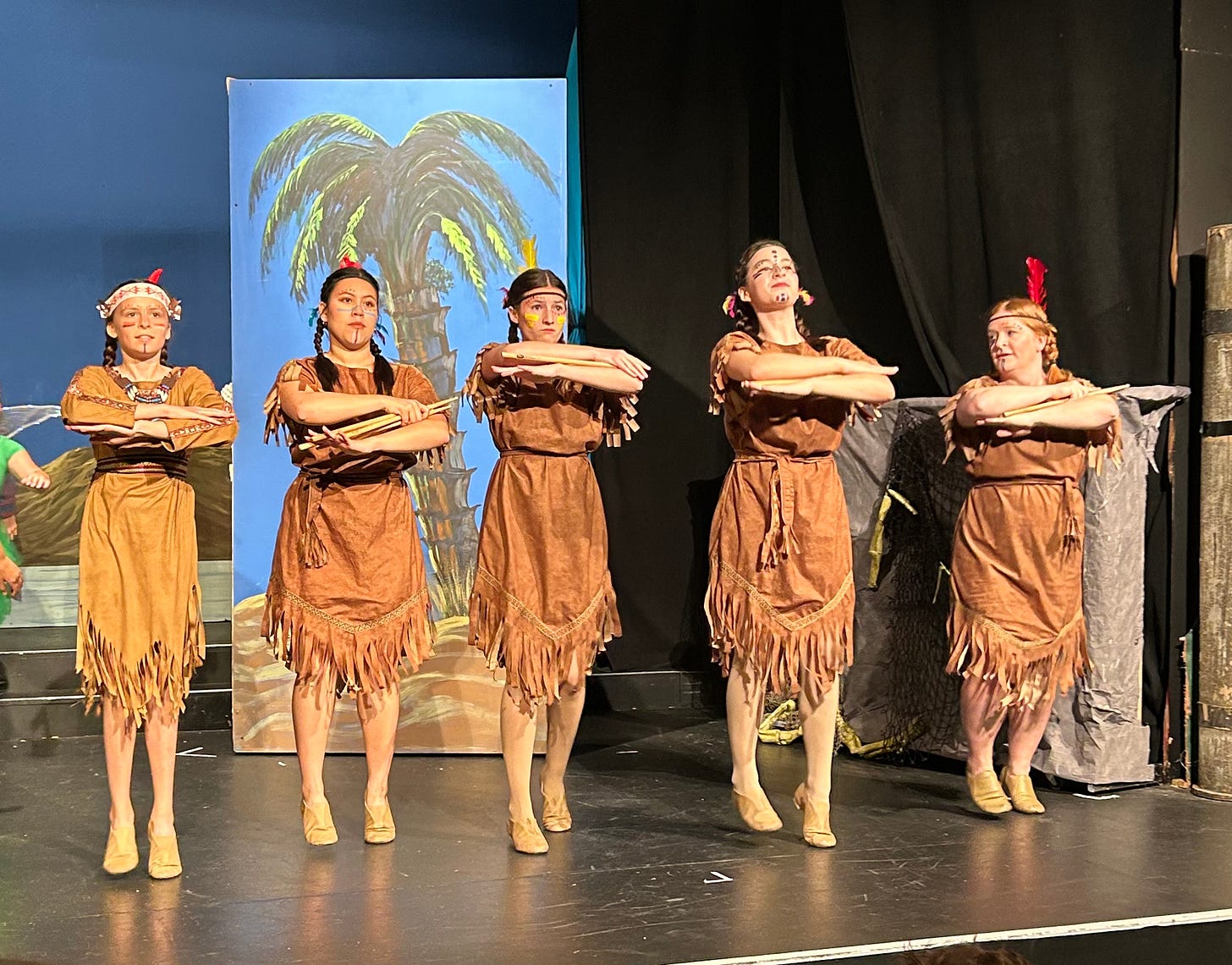The enduring dazzle to Peter Pan isn’t the wonder of watching actors believably fly, it’s the radical belief in magic against the punishing tide of a weary world. Through this prism, we allow a flashing light onstage to become a mischievous fairy. We accept an adult in a dog costume to be a dutiful pet named Nana. We look past the implied tragedy of how the Lost Boys arrived in Neverland and instead relish in their scampy thrill of finding a chosen family whose days are eagerly filled with bright, new Peter-led adventures. The show was never about soaring high above audiences.
Which is great news for the Musical Theatre Village in Irvine.
It’s only the second show of this series and I’m already at the, “the things I do for love” level where I, the proverbial Jamie Lannister, am pushing a Bran in the form of my own crippling sanity out the high tower to an assured death. True art often comes from suffering and I am gleefully the summer’s martyr, driving from the pit of the SF Valley to the pit of Orange County where this production of Peter Pan is being performed at the baffling hour of 11am in an industrial park off the 5-freeway. I am driving my husband’s car, because it is the car that can withstand pain. I am not bringing him along, because I am kind.
It is nearly impossible to track how many times Peter Pan has been performed in its 100+ year history, but I’m gonna try: there’s the original 1904 play by J.M. Barrie under the oft-forgotten full title, Peter Pan, or The Boy Who Wouldn’t Grow Up (glad we ‘The Facebook-ed’ that one). Then shortly after, a series of Barrie-penned sequels (my favorite title being, When Wendy Grew up - An Afterthought. As in, “An afterthought: I would like some money”). Then there was the first Broadway transfer in 1905 with actress Maude Adams who would remain the titular star for the next decade. Adams endured three separate revivals, eventually flying into Neverland in 1915 at the fun ’n flirty age of 43 — which is absolutely incredible news for Ben Platt in Dear Evan Hansen.
I’m gonna zip ahead to the 1954 Broadway musical, which is when we first got singing and dancing to our dogging and flying. This was of course the famous Mary Martin-led show choreographed and directed by Broadway legend Jerome Robbins (whose resume includes an impossible murderer’s row of West Side Story, The King and I, Fiddler on the Roof and of course my beloved Gypsy). Though Peter had been Pan-ing on-stage for half a century, Mary’s take on the perennial child left an imprint and soon all performers — regardless of gender — found themselves being quietly compared. This could be partly due to the show’s many Tony wins, partly due to the historic 1960 telecast which was later distributed widely on early VHS, quickly becoming a fatigued substitute teacher’s best friend. This could also be due to the fact that playing Peter seemed to leave an indelible mark on its stars. To be successful at this role, you must fully surrender to its childlike requirements— and what better way to “never grow up” than perform the same show night after night for literal years? Though Martin would later star in the original Broadway production of The Sound of Music (and win a Tony for it! You can’t adorn your mantle with a NOMINATION, Julie!!), it would be her embodiment of Peter that would eventually cast her in bronze, forever immortalized in her hometown of Weatherford in Parker County, Texas.
Now we’re over a century later and only two forms of entertainment exist: revivals of Peter Pan and re-tellings of Batman. Pan, like any Shakespeare production, has to be constantly performed by at least one theatre troupe at any given time or else the bomb on this bus will explode and Sandra Bullock will die. It, much like modern Shakespeare, hinges on its creative team to jazz up their show to stand out from its predecessors. Sometimes, this means a Taming of the Shrew done in the rollicking Wild Wild West. Sometimes this means a comedy farce like Peter Pan Goes Wrong coming soon to the Ahmanson Theatre. Today’s brunch performance at Musical Theatre Village is at both times twitching to modernize while being unbothered by its flashy predecessors. It’s a Pan whose shadow has been severed and doesn’t care to get re-sewn.
The world has changed since 1904. And 1954. And 1991, when even Steven Spielberg was so overwhelmed by the task of addressing the show’s depiction of its original non-white characters, he omitted them entirely from his absolute banger of a film Hook. Musical Theatre Village would like to acknowledge the original text’s “negative depictions and/or mistreatment of people or cultures” and make it clear they do not agree with such depictions. However, they would also not like to sanitize the past, but rather learn from its mistakes. They have decided to pursue the play’s original text in order to spark a conversation toward a more inclusive future.
Which is probably why there are 5 different young women playing Tiger-Lily.
At first I think it’s a mistake. Growing up in Performing Arts schools means being intimately familiar with double-casting due to over-populated theatre programs. Being in “Cast A” or “Cast B” is still the closest I’ve ever come to any kind of sportsmanlike pride (except for that one Super-Bowl where my husband’s precious Bengals played the LA Rams and I trash-talked so hard, the 4th quarter basically became our vow renewal). I flip through the rest of the program and find, somewhat reassuringly, somewhat forebodingly— that each and every principal role has been cast 4-6 times. My Wendy is one of 5. My Pan is one of 6. My Hook is one of 4, and I’m instantly reminded of the military-grade cognitive dissonance required of Bachelor contestants, knowing the love they give a singular audience may be split between multiple suitors.
There’s actually a real explanation for this. Musical Theatre Village (often shortened to “MTV” and I, as a child of the ‘90s, simply refuse) has the most radically inclusive casting policy I’ve ever heard in my entire dang life. Stated proudly on their website is the declaration that if your child is, “old enough to walk and sing, there is probably a part [for them] in the show.” Beyond just the multiple principles, I find heaps upon heaps of Lost Boys that seem to grow and stretch every time they run off-stage. Heaps of adult pirates, who seem to be the pseudo-chaperones to said Lost Boys. Some of these actors are mainly kept to the back, and some don’t have a firm handle on the choreography or songs, but they’re there. And they’re happy. And I’m grateful.
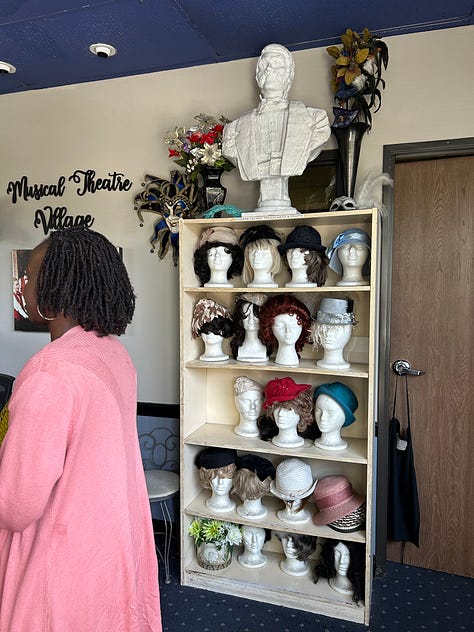
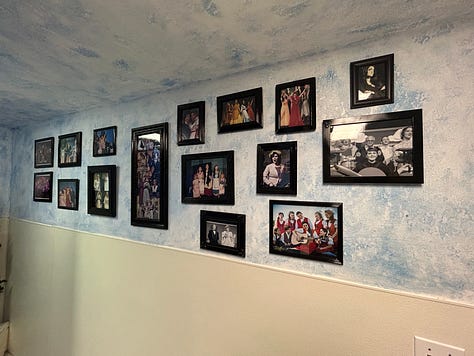
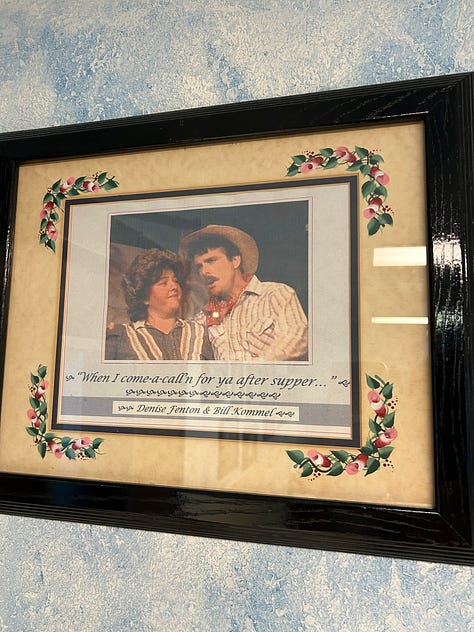
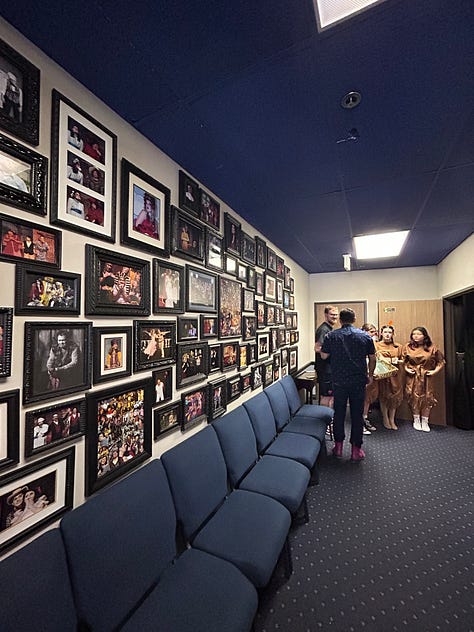
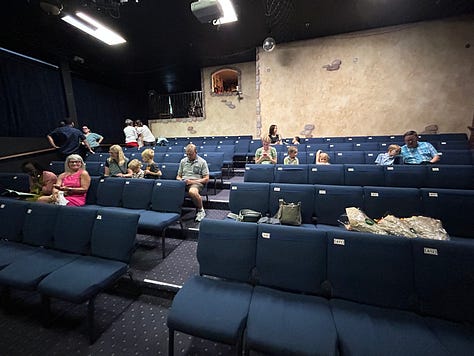

There’s a looseness in the air. Which I blame partly on the early hour and partly on the lobby being smaller than most Lululemon bathrooms I’ve defied the “customers only” policy for. This space, like all small theatres is a shrine to its past. Framed photos of previous performances absorb every available inch of wall, like a dramaturg’s TGI-Friday’s. A full shelf of loose wigs waits by the door like a world-weary Wal-Mart greeter. A thin black curtain is the only thing dividing the “backstage” to the outside world. Peeking through that curtain is our Tinkerbell, glimpsing the crowd and tittering excitedly to her fellow cast-mates on all the “Guffmans” they’re patiently waiting for. I open the bathroom and half-expect a Captain Hook indisposed, but instead am greeted with an extension of the lobby’s gallery. It takes me a whole beat to realize this is a special exhibit devoted to the theatre’s founder, Denise Fenton. It takes me an even longer beat to realize all the wigs are hers.
Denise is a veteran of over 250 shows, performing is in her blood. In the show’s program, she describes all her friends “going off to Broadways” while she stayed back for the practical calling of being a teacher. She, like so many beleaguered educators before her, got a first-hand glimpse at the perils of youthful temptation and describes her vision for starting MTV (okay, fine, it’s easier this way) stemming from her want to prevent her poor teenaged students from getting into the gang and drug culture so prevalent in her native San Bernardino. I nod in agreement because this is right. But also because this is the exact plot of Sister Act 2.
There’s a comforting ease to this “Temple of Trying” Denise has built. One that affords error and shrugs in the face of mistakes. In our show today, 2 out of 4 Tiger-Lily’s don’t make eye contact with the audience, instead shyly choosing to focus on the sound booth feet above our chairs. The Darling children occasionally talk over each other, which only makes their sibling bond more believable. When Peter (played by Jacob Voight) demonstrates the wonders of pixie dust, he “sprinkles” it over a flamingo toy hanging on the wall. The toy stays hanging limp, the crew clearly missing the cue. Voight turns back to the audience with a quiet shrug. Oh well. You get the picture. He continues to remain unshaken, even when he later sings, “I Gotta Crow” and FORGETS A SOLID CHUNK OF THE LYRICS. I simply can’t believe I’m witnessing this Actor’s Nightmare two shows in a row, but instead of last week’s School of Rock freak-out, today’s Peter is unflappable. He simply mutters “Sorry” as the MP3 continues and he waits patiently for his mental wheels to re-turn. And they do. And he jumps back in. And he doesn’t even break a sweat.
They say to be a good leader you need to hire someone for their talents, then walk away. It’s clear Denise has given her cast room to explore and they thrill in it. Our aforementioned Tinkerbell (played by Noelle McCormick Fuller) is a perfect mime, buzzing on-stage emphasizing the “manic” in manic pixie. What do you do when a role has absolutely no lines? You make yourself memorable by chewing every scene with a non-stop twitch, flick, bug-eyed reaction— she’s our unofficial narrator, our 1-woman Greek Chorus, our daughter of spastic dance. Even though her family’s clearly in the crowd, she’s rightfully earned all her hoot’s and holler’s.
Then there’s twin Lost Boys Curly (Camryn Schjei) and Nibs (Geneve Roundy) who have been given the hard task of standing out while fitting in. Playing twins is a tight-rope of easily tripping toward “Tweedle-Dee”, but instead our Boys (née girls) joyfully lean into each other as perfect scene partners, yes and-ing every line, move, and furtive glance. I find my eye naturally drawn to them as they give silent commentary to the on-stage action, like an after-show happening during the show. I love them and am shocked how much heavy lifting wigs can do to make someone look identical, I jot a quick mental note for an upcoming pitch for Twins 2.
Our adults don’t let the kids have all the fun. Joshua Orro is having an absolute blast as Smee, not caring one bit that he has a 33% of being the best. Karen Lindsey pulls double-duty as Liza the Maid and Igor the Pirate and while her Liza is polished and properly English, her Igor is loose and lively. She has made the actor’s choice of giving her pirate the backstory of being “tongue-less” and thus, speaks in a Minion-like gibberish in a way so convincingly, you know it’s her party trick. I sit in awe of her performance, quietly imagining the audition scene where Denise, as Spielberg, passionately avowed, “You got the part!”
But then there’s the catch. Because every club that speaks to a loose-leash creative freedom must have one. One of our pirates (played by a white woman) is performing her character with a “Hispanic accent”. And another, (played by an older white man) is doing his with an, “Asian accent”. I don’t know what to do with this information, besides present it. My research does not reveal it being in the original text, but maybe it was. I don’t believe the show would’ve suffered if it was omitted. I am hoping this sparks a conversation to a more-inclusive future.
And now, for a palate cleanser. Because I must discuss the Crocodile.
Our menace on-stage is played by Zoe Rank (who I truly don’t know is a child or an adult). She is not sweating that her Crocodile costume may read unrealistic. She’s not falling to the pressure of crawling on all fours. She’s a pupil at the “Less is More” school and proudly snatches her diploma by sauntering on-stage with an unhurried clip. She performs her scripted duty of taunting Captain Hook. Then, just as not-quickly as she came, she’s off. And when she’s back again, we rejoice. And perhaps knowing the audience is firmly in her claw, she adds an extra flourish of turning to the audience and “finger-gunning” us before she exits stage right, part reptilian Fonzi, part underwater Buddy Christ. Uta Hagen once encouraged us to overcome our notion to be regular, and Zoe is extraordinary. I think about her non-stop on the entire 1.5 hour drive home.
There’s something great about the lead of a child-centric show being played by an actual child. When Voight decries unfairness from the pirates, I believe him. When Wendy (played by an impressive and precocious Kensie Breen) tells him he’s being impossible, I agree with her. When the pirates are made to be buffoons, I know it’s because some of the Lost Boys are played by their literal children, with our own Peter being the son of this morning’s Captain Hook. I realize in highlighting these qualities, I’m naturally undercutting their acting ability. I realize that it’s easy for a Peter Pan to believably raise a plastic sword to a Captain Hook, especially when just moments ago he was yelling at you to get in the car. It’s easy to act like a child when you are a child, harder to convince an audience when you’re a 46-year old woman. But not all acting is about capital-A acting.
I’m overcome with this feeling in the second act, when Jacob Voight as Peter has a particularly impressive monologue. And it reminds me of all his other monologues. And the songs. And even the missed lyrics, which I don’t blame him for— he had a lot on his plate and something had to give. Jacob, perhaps unknowingly, has become the visual answer to the question Denise asked all those years ago. That performing in any capacity— on a brightly-lit stage or in a corner of an Irvine industrial park— is a canon event that does so much more than distract you from cocaine in San Bernardino. That theatre isn’t just about fame or Broadway ambitions or even having a “real backstage” or a bright neon sign (I forgot to mention, there’s truly no way to know this place exists from the street and you may very well stumble into a place called “NeurotriS” which is a ‘Center for Longevity Medicine’??).
It’s about doing something big, and weird, and hard and not even blinking when you completely fail. The world keeps turning. The MP3 continues. It’s not a big deal. You get the picture. This show will soon be over and later in the lobby, at the still-early hour of 1:30pm, two Captain Hooks will cross each other like ships passing in the night.
See you next week when we zip off to a theatre in the half-round in Long Beach, where a production of In the Heights is performed by 20-somethings (and only 20-somethings), and no one — not even I — am prepared for what the director wears to the opening night.





